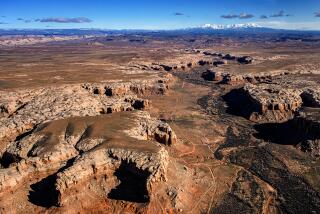Saving bits of the Old West’s history
- Share via
MOAB, UTAH — Dale Irish sometimes calls it “my bridge.”
So when the 92-year-old Dewey Bridge, about 30 miles northeast of town, burned this spring, Irish’s neighbors offered condolences.
“Everybody in Moab called me. You’d think I’d lost my lovely wife,” said Irish, 79, a lifelong Moab resident who led an effort to refurbish the bridge eight years ago.
The April fire, started by a 7-year-old boy playing with matches along the Colorado River, destroyed not only the bridge’s wooden white frame but also a significant piece of the region’s history.
When it was built in 1916, Dewey Bridge was the second-largest suspension bridge west of the Mississippi, stretching more than 500 feet across the roiling, muddy waters of what was then called the Grand River. It provided a lifeline for southeastern Utah farmers and ranchers trying to get their products to market, and a safer alternative to the fledgling ferry service that was “prone to vanishing downriver during periods of high water,” according to one history of the bridge.
The bridge was also the last link to the vanished town of Dewey, which today is little more than a scrubby collection of sagebrush, rocks and a few wandering cows.
“Boards can be replaced, but it’s memories, all the memories that go with it,” said Irish’s wife, Wilda, 71.
Despite years of preservation efforts, bits and pieces of Western history are disappearing and, with them, insight about the early days of European settlement. Time, simple neglect and natural decay doom some. Others are sped along in the name of progress or safety.
Many leave a hole, however tiny, in the story of the West.
“The problem is they’re nonrenewable resources,” said Ron James, Nevada’s historic preservation officer for the last 25 years.
Preservation of historic buildings, bridges and other structures tends to favor the grand, the notable and the notorious. But small farmhouses, barns, bridges, windmills and other ordinary places provide important insight into the everyday lives of settlers struggling to survive on the unforgiving landscape of the West, said Richard Moe, president of the National Trust for Historic Preservation, a private nonprofit group. “Without them, we get a distorted, romanticized view of the past,” he said.
In the absence of written records, stories are often discerned from what’s left behind.
Bonnie J. Clark, a historical archaeologist at the University of Denver, recalled visiting a wind-swept homestead west of Salt Lake City where a bedspring had been improvised as a fence gate.
“You could tell this was a place where they were doing everything they could to make it,” Clark said. “That’s the story of the American West for me right there.”
Another settlement in Colorado illuminated the folly of spending too much time on a stone house and not enough time tending crops. Those homesteaders lasted only a few years, Clark said. More successful settlers started living in a dugout and added a house only after the crops were established.
“We tell the story of the triumphs, but the landscape tells you the story about where people got it wrong,” Clark said.
Plain-looking hay barns, toll roads or mining camps are easily overlooked in the shadow of more majestic artifacts, she said.
In many cases, especially at first-generation ranches, the items left behind are a window into how people built communities and survived. Those lessons could apply today as the West continues to grow and more attention is focused on sustainable communities, said Kat Vlahos, an associate professor of architecture and planning at the University of Colorado Denver.
In northwestern Wyoming, crews have been working for years to shore up a remote mining town called Kirwin, where some 200 people once eked out a living pursuing gold and silver. The town survived for about 16 years before a 1907 avalanche drove out most of its residents. Now considered a ghost town, Kirwin has become a pet cause of a group of volunteers hoping to preserve its essence.
Not every ranch, outbuilding or bridge can or should be saved, historians say. Already, more than 80,000 properties are listed on the National Register of Historic Places, including the Dewey Bridge near Moab.
The listing, though, is only an honorific designation and doesn’t provide specific protections. That tends to come at the local level, often through zoning, said Barbara Murphy, Utah’s deputy state historic preservation officer.
More to Read
Sign up for Essential California
The most important California stories and recommendations in your inbox every morning.
You may occasionally receive promotional content from the Los Angeles Times.













